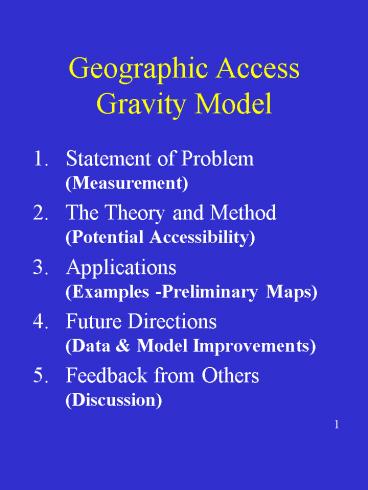Geographic Access Gravity Model PowerPoint PPT Presentation
1 / 23
Title: Geographic Access Gravity Model
1
Geographic Access Gravity Model
- Statement of Problem (Measurement)
- The Theory and Method (Potential Accessibility)
- Applications (Examples -Preliminary
Maps) - Future Directions (Data Model
Improvements) - Feedback from Others (Discussion)
1
2
The Problem(s) - Measurement
- How to MEASURE geographic access to health care
providers and facilities? - The proposed solution - Develop a reliable method
to MEASURE (and compare) the distribution of
facilities/providers and the population. - Reliable MEASUREMENT requires a geographic
framework in which to collect and organize
observations.
2
3
The Problem(s)
- Reliable MEASUREMENT requires a common scale that
allows for relative comparison of values. - Reliable MEASUREMENT requires a method to handle
arbitrary boundaries imposed by a data collection
geographic framework.
3
4
The Geographic Framework - ZIP Codes
- Health care data (patient, provider, facility,
etc.) have many geographic (locational)
components. - Some geographic components are geographic
coordinates, county, census block and tract,
etc.). - An address with a ZIP Code is a commonly used
geographic component and provides sufficient
spatial resolution (many and delineated following
population). They are our choice.
4
5
NM ZIP Codes
- US Postal Service delivery areas.
- Some ZIP Codes do not have rural delivery and
mail is picked up at the Post Office. - There can be multiple ZIP Codes per post office
(delivery and no delivery). - DGR has prepared a ZIP Code base map (coverage)
for NM with 400 ZIP Codes for mapping HPC Data
(new ZIP Codes are being added - Currently 403). - We added (estimated) boundaries for 125 ZIP Codes
(USPS review).
5
6
(No Transcript)
7
(No Transcript)
8
(No Transcript)
9
A Common Measurement Scale
- Service Capacity Standards (traditional measure -
Fed. and State guidelines). - Ratio of provider or facilities per population.
- Can be expressed as either
- One M.D. per 1,500 persons (Prov./ Pop.)
- 1,500 persons per M.D. (POP. / Prov.) What we use.
8
10
The Boundary Problem
- Traditional measures (service capacity standards)
NOT very good. Problem of arbitrary boundaries. - Does NOT consider that people move among
communities or political/data collection units to
obtain medical services. - Nobody pays attention to what ZIP Code their
doctor is in. - Does NOT consider distance (close or far).
9
11
(No Transcript)
12
The Theory
- Spatial Interaction - The closer together
phenomena are the easier it is for interaction to
take place and the more similar they are.
(Toblers Law 1st Law of Geography). - Spatial Interaction - Assumed to decline with
increasing distance. - Distance Decay - The result of declining
interaction - termed friction of distance.
11
13
The Method (Spatial Analysis)
- Gravity Models have been used in economics and
social sciences since William Reily (Univ. of
Texas) proposed the idea in 1929. - Gravity Models have been traditionally used in
retail studies, but recently in health care. - Gravity Models allow for the measurement of
spatial interaction as a function of distance.
12
14
Original (Retail) Gravity Model
or
Interaction between two areas i and j
Population of each area
Distance between areas
Distance exponent - the higher the greater the
friction of distance
13
Market area definition (polygons)
15
(No Transcript)
16
Potential AccessibilityDGRs Gravity Model
PAj Potential Accessibility for ZIP Code j
popi Population of ZIP Code i
provi Number of providers/facilitie
s in ZIP Code i f(dij) 1
for all dij all 35 for all dij 100
17
Distance Decay(Rule-Based Function)
18
Test Applications
- Have done initial development and testing.
- Preliminary survey data used to test gravity
model. - Also population estimates for ZIP Codes.
- Test maps for
- Hospital Beds
- Primary Care Physicians
- Registered Nurses
- General Dentists
15
19
(No Transcript)
20
(No Transcript)
21
Future Directions
- Use new (improved) data from licensing boards on
a quarterly basis. - Train HPC staff to use the Excel and SAS based
version. - Develop with ArcView 3.x and Avenue scripts (was
being considered in 1999). - Develop a new version using ArcGIS (ArcMap) and
ArcObjects (VB/A). - Address the Edge Problem --
Peripheral area data (Arizona, Colorado, Texas
and Mexico?)
19
22
Future Directions
- Enhance gravity model for demographic and risk
factor analyses. (multivariate techniques data
available from ESRI BIS/ArcView Business
Analyst). - Investigate using travel time instead of straight
line distance (NM roads Arc/Info network
coverage) - Review recent literature.
- Prepare a presentation and publication.
20
23
Questions and Open Discussion
- Internal Web Page
- wwwdgr.unm.edu/hpc/hpc_grav.html
- Has MORE DETAIL Was Up to date
21

